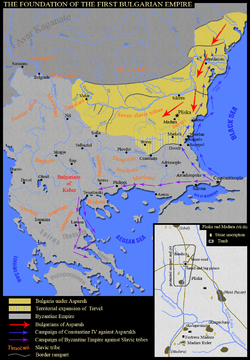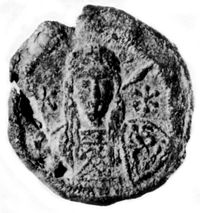
Treaty of 716
Encyclopedia

First Bulgarian Empire
The First Bulgarian Empire was a medieval Bulgarian state founded in the north-eastern Balkans in c. 680 by the Bulgars, uniting with seven South Slavic tribes...
and the Byzantine Empire
Byzantine Empire
The Byzantine Empire was the Eastern Roman Empire during the periods of Late Antiquity and the Middle Ages, centred on the capital of Constantinople. Known simply as the Roman Empire or Romania to its inhabitants and neighbours, the Empire was the direct continuation of the Ancient Roman State...
. It was signed by the son of the ruling Bulgarian Khan
Khan (title)
Khan is an originally Altaic and subsequently Central Asian title for a sovereign or military ruler, widely used by medieval nomadic Turko-Mongol tribes living to the north of China. 'Khan' is also seen as a title in the Xianbei confederation for their chief between 283 and 289...
Tervel, Kormesiy
Kormesiy of Bulgaria
Kormesiy was a ruler of Danubian Bulgaria in the first half of the 8th century. Western chronicles name Kormesiy "the third ruler over the Bulgarians", and he is sometimes considered the direct successor of Tervel....
and the Byzantine Emperor Theodosios III
Theodosios III
Theodosios III or Theodosius III , was Byzantine Emperor from 715 to March 25, 717.Theodosius was a financial officer and tax collector in the southern portion of the theme of Opsikion. According to one theory he was the son of the former Emperor Tiberius III. When the thematic troops rebelled...
.
Background
In 705705
Year 705 was a common year starting on Thursday of the Julian calendar. The denomination 705 for this year has been used since the early medieval period, when the Anno Domini calendar era became the prevalent method in Europe for naming years.- Asia :* Armenia: The Umayyad general Muhammad ibn...
AD, the deposed Byzantine emperor Justinian II
Justinian II
Justinian II , surnamed the Rhinotmetos or Rhinotmetus , was the last Byzantine Emperor of the Heraclian Dynasty, reigning from 685 to 695 and again from 705 to 711...
asked the Bulgarian khan Tervel for assistance to regain his throne. The Bulgarians sent 15,000-strong army and Justinian entered Constantinople. Tervel was awarded with the title Caesar
Caesar (title)
Caesar is a title of imperial character. It derives from the cognomen of Julius Caesar, the Roman dictator...
, huge amount of gold, silver and garments as well as the region called Zagore to the south of Stara Planina. However, when he stabilized his position he invaded Bulgaria to retake the lost territory but was defeated in the Battle of Anchialus (708)
Battle of Anchialus (708)
The Battle of Anchialus occurred in 708 near the town of Pomorie, Bulgaria .- Origines of the conflict :In 705, the Bulgarian Khan Tervel helped the ex-emperor of Byzantium, Justinian II to regain his throne after 10 years in exile...
and later executed by his political rivals. The hostilities continued until 716 a treaty was signed between Bulgarians and Byzantines.
Settlements


- The Byzantine Empire recognized the Bulgarian borders including the newly gained lands of ZagoreZagoreZagore ; also Zagorie, Zagora, Zagoria) was a vaguely defined medieval region in Bulgaria. Its name is of Slavic origin and means "beyond [i.e. south of] the [Balkan] mountains"...
. In the treaty, the border between the two countries was stated as beginning at Mileoni in ThraceThraceThrace is a historical and geographic area in southeast Europe. As a geographical concept, Thrace designates a region bounded by the Balkan Mountains on the north, Rhodope Mountains and the Aegean Sea on the south, and by the Black Sea and the Sea of Marmara on the east...
. However, Mileoni cannot be identified in the text but it obviously stands as a geographical term. According to Konstantin JirečekKonstantin Josef JirecekKonstantin Josef Jireček , son of Josef Jireček, was a Czech historian, diplomat and slavist.He entered the Bulgarian service in 1879, and in 1881 became minister of education at Sofia...
, Mileoni should be identified with one of the peaks of the Manastir Heights on the northern foothills of the Sakar Mountain. On the highest peak (590 m) there are ruins of a fortress of a type typical for a Byzantine border outpost and most probably it served as a border point. The border was defined by means of a trench (Erkesiya), known in the Middle Ages as the "big trench". It began from the lagoons around the Mandra Lake to the north of the ruins of DebeltDebeltDebelt is a village in Sredets municipality in Burgas Province in southeastern Bulgaria, about 25 kilometers from Burgas. It has a population of 1,574 and an altitude of 46 meters. The village was founded around the 2nd century by the Roman emperor Vespasian. Then called Deultum, it was the only...
and ran westwards to the Maritsa River with a length of 131 km. - The Byzantine Empire must continue to pay annual tribute to Bulgaria. The annual tribute agreed in 679 between AsparukhAsparukh of BulgariaAsparuh was ruler of a Bulgar tribe in the second half of the 7th century and is credited with the establishment of the First Bulgarian Empire in 680/681...
and Constantine IVConstantine IVConstantine IV , , sometimes incorrectly called Pogonatos, "the Bearded", by confusion with his father; was Byzantine emperor from 668 to 685...
and confirmed by Justinian IIJustinian IIJustinian II , surnamed the Rhinotmetos or Rhinotmetus , was the last Byzantine Emperor of the Heraclian Dynasty, reigning from 685 to 695 and again from 705 to 711...
was reaffirmed. - Both countries agreed to exchange refugees charged with conspiracy against the legal ruler. This term was pushed by Theodosios III because his authority was not stable and the Bulgarians had in the past helped rebels to take the imperial crown.
- Goods could only be imported or exported when provided with a state seal. Goods without documents were to be confiscated for the state treasury. The Bulgarian merchants gained official access to Europe's largest market in Constantinople.
Aftermath
The treaty was in Bulgaria's favour but it proved to be vital for the Byzantine Empire. Based on that agreement the Bulgarians sent army to relieve the Second Arab siege of ConstantinopleSiege of Constantinople (718)
The Second Arab Siege of Constantinople was a combined land and sea effort by the Arabs to take the capital city of the Byzantine Empire, Constantinople. The Arab ground forces, led by Maslamah ibn Abd al-Malik, were held off by the massive city walls, decimated by an outbreak of plague and...
and defeated the Arabs in the decisive battle near the city. In 719 Tervel withdrew his support for the new pretender for the Byzantine throne Anastasius. The treaty lasted until 756 when the Bulgarian Khan Kormisosh
Kormisosh of Bulgaria
Kormisosh was a ruler of Bulgaria during the 8th century.The Namelist of Bulgarian Rulers states that he belonged to the Ukil clan and ruled for 17 years. According to the chronology developed by Moskov, Kormisosh would have reigned from 737 to 754...
asked for tribute for the newly constructed Byzantine border fortifications but his envoy was ignored. A long period of Byzantine–Bulgarian wars began which lasted with interruptions for more than half a century. Despite the initial Byzantine successes in 792, 811 and 813 they suffered crushing defeats. A year before the battle of Versinikia
Battle of Versinikia
The Battle of Versinikia was fought in 813 between the Byzantine Empire and the Bulgarian Empire, near the city of Adrianople in contemporary Turkey....
in 813 Khan Krum offered the Byzantines to reestablish the Treaty of 716. However, his offer was declined because of the third point of the treaty concerning the exchange of political refugees. The Byzantines still had illusions that they could interfere in the Bulgarian internal affairs after the series of weak and short-ruled Bulgarian khans in the second half of the 8th century. After the death of Krum, a new 30-year peace treaty
Treaty of 815
The Treaty of 815 was a 30-year peace agreement signed in Constantinople between the Bulgarian Khan Omurtag and the Byzantine Emperor Leo V the Armenian.- Background :...
was signed in 815 between the new Khan Omurtag and Leo V the Armenian
Leo V the Armenian
Leo V the Armenian was emperor of the Byzantine Empire from 813 to 820. A senior general, he forced his predecessor, Michael I Rangabe, to abdicate and assumed the throne. He ended the decade-long war with the Bulgars, and initiated the second period of Byzantine Iconoclasm...
.

